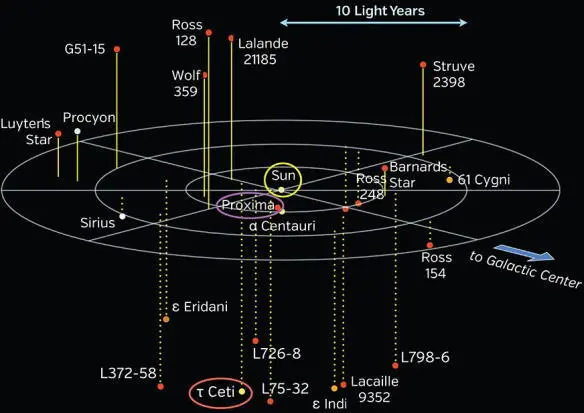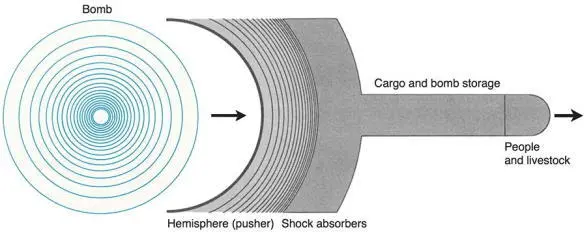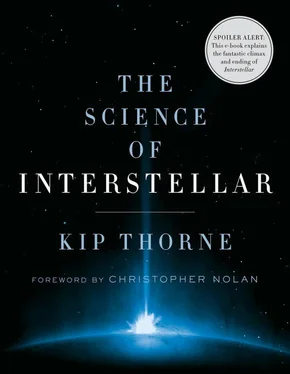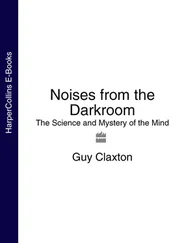Professor Brand tells Cooper, in their first meeting, that the Lazarus missions have been sent out to search for new homes for humanity. Cooper responds, “There’s no planet in our solar system that can support life, and it’d take a thousand years to reach the nearest star. That doesn’t even qualify as futile. Where did you send them, Professor?”
The worse-than-futile challenge, if you don’t have a wormhole, is obvious when you realize just how far it is to the nearest stars (Figure 13.1).
Distances to Nearest Stars

The nearest star (other than our Sun) thought to have a habitable planet is Tau Ceti, 11.9 light-years from Earth, so traveling at light speed you would need 11.9 years to reach it. If there are any habitable planets closer than that, they can’t be much closer.
To get some sense of just how far Tau Ceti is compared to more familiar things, let’s scale its distance down enormously. Imagine it as the distance from New York City to Perth, Australia, about halfway around the world.

Fig. 13.1. All the stars within 12 light-years of Earth. The Sun, Proxima Centauri, and Tau Ceti are circled in yellow, purple, and red. [I adapted this map from Richard Powell’s www.atlasoftheuniverse.com.]
The very nearest star other than the Sun is Proxima Centauri, 4.24 light-years from Earth, but there is no evidence it has habitable planets. With Tau Ceti’s distance imagined as New York to Perth, then Proxima Centauri’s is like New York to Berlin. It’s not a lot closer than Tau Ceti!
For comparison, the most distant unmanned spacecraft that humans have sent into interstellar space is Voyager 1 , now about 18 light-hours from Earth. It has been traveling for thirty-seven years to get there. With Tau Ceti’s distance imagined as New York to Perth, then Earth to Voyager 1 is about 3 kilometers (2 miles): the distance from the Empire State Building to the southern end of Greenwich Village. That’s hugely less than New York to Perth.
The Earth to Saturn is even smaller: 200 meters, two east-west blocks in New York City, from the Empire State Building to Park Avenue. The Earth to Mars is just 20 meters; and the Earth to the Moon (the greatest distance humans have ever yet traveled) is just 7 centimeters—about two and a half inches!
Compare what we have achieved in going to the Moon, two and a half inches , with the challenge of going halfway around the world . That’s the leap of technology required to take humans to habitable planets outside our solar system!
Travel Times with Twenty-First-Century Technology

Voyager 1 is traveling out of the solar system at 17 kilometers per second, having been boosted by gravitational slingshots around Jupiter and Saturn. In Interstellar , the Endurance travels from Earth to Saturn in two years, at an average speed of about 20 kilometers per second. The fastest speed I think rocket technology plus solar system slingshots are likely to achieve in this, the twenty-first century, is about 300 kilometers per second.
At that 300 kilometers per second, we would need 5000 years to reach Proxima Centauri and 13,000 years to reach Tau Ceti. Not a pleasant prospect!
To get there far faster in the tweny-first century, you need something like a wormhole (Chapter 14).
Far-Future Technology

Technically savvy scientists and engineers have put much effort into conceiving far-future technologies that might make possible near-light-speed travel. You can learn a lot about their ideas by browsing the web. It will take many centuries for humans to make any of those ideas real, I think. But they do convince me that ultra-advanced civilizations are likely to travel between the stars at a tenth the speed of light or faster.
Here are three far-out examples of near-light-speed propulsion that intrigue me.
Thermonuclear Fusion

Thermonuclear fusion is the most conventional of the three ideas. R&D to develop controlled-fusion power plants on Earth was initiated in the 1950s, and full success will not come until the 2050s. A full century of R&D! That’s a realistic measure of the difficulties.
And what will fusion power plants in 2050 mean for spacecraft propulsion by fusion? The most practical designs may achieve 100 kilometers per second, and conceivably 300 kilometers per second by the end of this century. A whole new approach to harnessing fusion will be required for reaching near light speed.
A simple calculation shows fusion’s possibility: When two deuterium (heavy hydrogen) atoms are fused to form a helium atom, 0.0064 (nearly 1 percent) of their rest mass gets converted into energy. If this were all transformed to kinetic energy (energy of motion) of the helium atom, the atom would move at about one-tenth the speed of light. [26] The kinetic energy is Mv 2 /2, where M is the helium atom’s mass and v is its speed. Equate this to the energy released, 0.0064 Mc 2 , where c is the speed of light. (I used Einstein’s famous result that when you convert mass into energy, the energy you get out is the mass multiplied by the square of the speed of light.) The result from equating these two formulas is v 2 = 2 × 0.0064 c 2 , which means v is close to c/10 .
This suggests that, if we could convert all the fusion energy of deuterium fuel into ordered motion of a spacecraft, we could achieve a spacecraft speed of roughly 1/10 the speed of light—and somewhat higher if we are clever.
In 1968 Freeman Dyson, a brilliant physicist for whom I have great respect, described and analyzed a crude propulsion system that, in the hands of a sufficiently advanced civilization, could achieve this.

Fig. 13.2. Freeman Dyson’s bomb-powered propulsion system. [From Dyson (1968).]
Thermonuclear bombs (“hydrogen bombs”) are detonated just behind a hemispherical shock absorber that is 20 kilometers in diameter (Figure 13.2). The bomb debris pushes the ship forward, achieving, in Dyson’s most optimistic estimate, a speed one-thirtieth that of light. A less crude design could do somewhat better. In 1968 Dyson estimated that such a propulsion system would not be practical any sooner than the late twenty-second century, 150 years from now. I think that’s overly optimistic.
Laser Beam and Light Sail

In 1962 Robert Forward, another physicist whom I respect, wrote a short article in a popular magazine about a spacecraft with a sail, pushed by a distant, focused laser beam (Forward 1962). In a 1984 technical article, he made this concept more sophisticated and precise (Figure 13.3.)
An array of solar-powered lasers in space or on the Moon generates a laser beam with 7.2 terawatts of power (about twice the total power consumption of the United States in 2014!). This beam is focused, by a Fresnel lens 1000 kilometers in diameter. It is focused onto a distant sail, 100 kilometers in diameter and weighing about 1000 metric tons, that is attached to a less massive spacecraft. (The beam direction must be accurate to about a millionth of an arcsecond.) The beam’s light pressure pushes the sail and spacecraft up to about a fifth the speed of light halfway through a forty-year trip to Proxima Centauri. A modification of this scheme then slows the ship down during the second half of the trip, so it arrives at its destination with a speed low enough to rendezvous with a planet. (Can you figure out how the slow down is achieved?)
Читать дальше

















